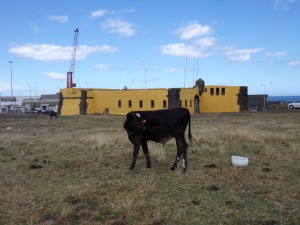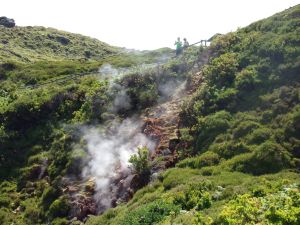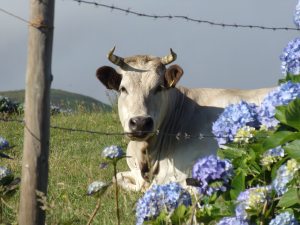The trip from Terceira to the Channel was in two parts, first go north, then go east. The forecast showed south easterlies for the first few days, then reducing and backing to northerly, continuing to back and freshening again from NW, giving a good boost towards the east. This is pretty much what happened. At first we were able to put the wind on the starboard quarter and still point the bow towards the Scillies. I was using Bishops Rock as a waypoint, expecting to put in at Scilly for a day, or a tide, if conditions were suitable. If not, we would at least be north of the TSS and clear of most big shipping in the channel.

A friendly Ray in Praia says goodbye
The first night was a bit lively. We banged along with one reef in the main and the No 2 jib. After dark there was frequent lighting ahead of us. It was too far away to see the lighting bolts, or hear any thunder, but the tops of the clouds flashed bright enough to light up inside the cabin. The radar alarm beeped with each flash. It was too far away to present any risk, but I wanted to keep a watch in case we were running into danger. After the storms died away, the radar started bleeping again with a distant ship. It didn’t appear on AIS but was within range for nearly two hours. It was probably a slow moving ship going in the same direction and about 20 miles or more away.
By morning the wind had backed a little and I tweaked the rig to bring the wind further forward. Just sliding the sheet back down the tiller is usually enough. We carried on with short sail throughout the second day, but it eased just before sunset. I was tempted to increase sail, but opted for a quiet night. In the morning the wind picked up again and we were back to a force 4 or 5 for another day.
Tuesday morning the wind did ease off as expected and we set full sail. The afternoon was sunny and I had a wash in the cockpit with solar heated water. It was easy but not spectacular sailing with winds gradually easing and backing.
The next afternoon I saw a whale at some distance, too far away to even guess the species. At 1900 there was just a light breath from NNE, and we tacked, pointing east. A whale went past at about 200m distance. Just about as the sun set a whale, probably the same one, surfaced just 50m off the beam. Luckily I was in the cockpit at the time. I would guess it was about 10m long, and judging by the shape of the back and hooked fin, it was probably a large Minke. I have seen a few whales this time, and noticed that they seem to approach more closely in calm conditions. In contrast the dolphins are much more interested if we are moving quickly and bashing around.
Overnight the wind picked up again and we had a good run with the wind increasing and backing further. Noon to noon we made good 124 miles. I had been unable to get a radio signal from Northwood for weatherfax, and the signals from Offenbach were sometimes distorted. I found fiddling with the aerial connector was some use, and tightening the connector on the back of the radio, I broke it off inside. I didn’t know until it was opened up, but it was either the radio or the aerial. In the morning I put another reef in the main as we were bumping around too much for extreme soldering. The radio was a very easy repair, just soldered a wire back onto the connector, then tightened up the backnut. There was still no signal from Northwood, so I used the Offenbach ones. The synoptic charts have no geostrophic scale, so working out the wind speed is more difficult. I hope that normal service is resumed from Northwood. By now the late night shipping forecast was audible on the BBC, although we were well outside the areas covered.
The wind eased again the next day, Saturday and I went to set full sail. Hoisting the genoa it caught on a cleat and when I went to free it, about a metre of leech had torn. I could repair it like the last time, but that repair had taken three days, and this one is three times as long. It would be very difficult to do a good job without a big table to lay it flat, and I am not sure that I would be worth it anyway, as rest of the leech would be suspect. For now it will be the old blue genoa, or the number 2, or if the wind is really light, the cruising chute. I couldn’t repair the genoa, so did the hole in the floor instead and through-bolted it.
Sunday started cloudy day, but lived up to its name eventually. The radio was still a bit scratchy but we were able have it tuned in during the day. I found a cable from the big solar panel had broken, so soldered that. Warm enough for a solar heated wash and dry. I baked a longitude cake, meant to do it earlier, but now each degree would warrant a larger slice.
Monday I took the sextant out of its box. A large tanker was passing at 4.5 miles and I wondered how long it is. It measured 2 degrees 30 minutes, and as one degree is 1:60, that works out at around 300m. I might even try a sun sight one day.
On Tuesday the radio reception was very clear, and the noon weather forecast was worrying, warning of strong winds and rain due to the remnants of Hurricane Bertha, with the worst to come on Sunday. We were nearly 300 miles from Scillies. I would need to take the sailing quite seriously, adjusting the sails to take best advantage of the wind shifts and take careful note of the forecasts. The lack of the genoa was an issue, as only the smaller No 2 was available to pole to windward.
The weatherfax in the morning was not too drastic. It looks like there will be strong westerlies on Saturday and Sunday. It looks worse in the north, and probably no more than force 6 at Scilly. The anchorages are a bit exposed, so I would probably carry on to Penzance. The shipping forecast was for winds becoming variable. The weatherfax suggests southeasterlies at midnight Thursday, so I would avoid heading north of the waypoint, which would leave us closehauled. It was a pleasant day, with a sunny start, and feeling warm with the light winds. The drop in temperature has been noticeable with the sleeping bag putting in an appearance and now socks to wear at night.
The winds becoming lighter, I got the cruising chute out. With no snuffer, I set put this sail up or down in the lee of the mainsail. I use an autopilot to keep a steady course while doing this. It is the only time I use it, as it continually hunts from side to side, wasting electricity and driving me crazy. It is useful for the chute though, as it would be too easy to rip this sail if it got out of control. The autopilot didn’t work, although the light came on and it beeped encouragingly. I abandoned the idea, but after two hours of creeping along at one knot, I decided to put it up anyway. If we were to have any chance of staying ahead of Bertha, we would need to get some miles on the log.
I was pleased that the cruising chute would not only fly, but it would also self steer. It had to be watched as the wind was a bit changeable, but I was able to get on with some other jobs in the cockpit. I tackled the autopilot, which turned out to be some corrosion in the plug and socket. I only fitted these in May. The last ones were in place for 6 years, including the Atlantic circuit. The autopilot has only been used twice, but the socket also does the anchor light. Flushed with my success as an electrician, I got the old bilge pump, which stopped working in Praia, out and dismantled it, cleaned and sprayed it all and reassembled. It now works! Then I cleaned some other bits and pieces in a cockpit locker, a job on my to-do list since Plymouth.
The cruising chute came down with the sun and the old genoa went back up, only to come down again as the wind died and we were just rolling around. With no wind at all, I took the main down. As I was flaking it down over the boom, my hand went through the leech. It hadn’t caught on anything. The cloth just ripped. Luckily it was a small tear, but it doesn’t fill me with confidence about the strength of the sail. It was too dark to do anything about it, so I tied it to the boom and waited for the morning.
I was woken before dawn by the radar alarm. I had some breakfast waiting for light, then took the sail off the boom. I had sorted some sail repair cloth in the evening. I cut a piece to go across the repair and stuck it down, pressing hard and rubbing it down. It went back up, then it was a case of waiting for enough wind to fill it. There was a very light northerly. The leech didn’t look too bad. There is not a single length of leech that goes for a whole panel so any further tear could only spread to the next batten pocket or reinforcing patch. I hope there is no further tear. It only has to last another 400 miles.
The wind veered quickly and we then tacked with a SSE breeze allowing us to steer the direct course. The wind increased a little more and we broke the 2 knot barrier. Also the sun is shining and TMS is on the radio.
I didn’t use the computer again for a few days, apart from weatherfax, as the battery voltage seemed to be a bit low. It turns out that the large panel was giving out voltage, but one of the connector plugs was not making a good contact in the socket, although it appeared fine. Wrapping some aluminium foil around it did the trick but it would take a few days sunshine to top the battery fully. There really is a need for a paraffin fuelled computer.
After the main went up, the wind was very even handed for 2 days. First N, then SE, SSE, S, SbE, SSE, SW, NW, NNW, NW, WbN, WbS, SW then SSW. There may have been a few I missed when asleep. Not that there was much sleep as there was quite a bit of traffic. So there was a bit of sail tinkering, but only one blow that needed reducing sail. Mostly we enjoyed force 4 and made good progress.
All week there had been warnings of the remnants of hurricane Bertha promising heavy wind and rain on Sunday, and the forecast suggested gales for late Saturday. This ruled out Scilly and I planned to get into Penzance where we would dry out in the harbour and be well sheltered.
At first light the Isles were visible, very low to port and Land’s End was ahead. The wind was now from directly behind, so we had to head off to put the wind on one quarter then the other to allow self steering. It would have been possible to set two headsails on long poles, but with the newer genoa damaged, it would have been a bit slow and in any case the wind was not likely to remain constant. It turned out a pleasant morning with sunshine enough to heat water for a solar wash.
We arrived at Penzance two hours before HW, having put 1195 miles on the log since Praia, and a total of 5097 from Southampton. Bertha arrived sometime overnight. I slept well. This is the first time this year we have dried out. The bottom is mostly clean, just a little slime in a few places. There is no serious problems with damage or wear and tear, but a number of smaller things that need attention before next season, so we will probably return to Southampton then come out of the water and start cleaning and repairing.































